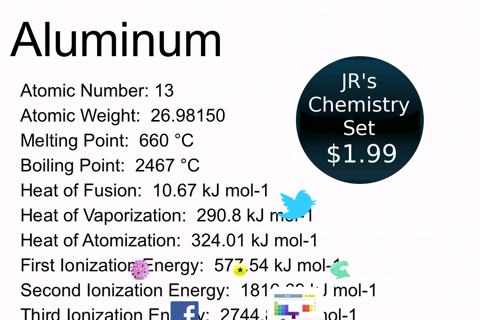
A New Periodic Table for Chemistry The Rota Period app for iPhone and iPad
Developer: Worldrecords.com
First release : 28 Jul 2012
App size: 20.46 Mb
Now in 20 languages! English, Spanish, French, German, Russian, Japanese, Italian, Portuguese, Chinese, Greek, Korean, Malay, Danish, Dutch, Finnish, Norwegian, Swedish, Thai, Turkish and Vietnamese.
Based upon the innovative Rota Period, this free periodic table for chemistry is a handy reference tool.
There are several unique structural things about the Rota Period that make it easy to understand and use:
1. It uses 12 columns (groups) instead of 18 or 32.
2. The 5+, 6+, 7+, and 8+ elements have their own unique position in the periodic table.
3. It uses the horizontal and vertical of the page to displace elements.
4. It is based upon showing valences, not orbitals.
The above items allow for the following benefits:
1. It incorporates the Lanthanide and Actinide Series (i.e. do not need separate tables for these).
2. It is very easy to see valences and the relationships between elements. For example, it is very easy to see how Titanium and Zirconium are related to Carbon (they are all 4+s).
3. It clearly separates the negative (nonmetal) elements from the positive (metal) elements.
Similar to Mendeleevs original periodic table the Rota Period is based on displaying valences, not orbitals. The Rota Period is easy to teach, easy to learn and easy to remember.
The following data is included: Atomic Number, Atomic Weight, Melting Point, Boiling Point, Heat of Fusion, Heat of Vaporization, Heat of Atomization, First Ionization Energy, Second Ionization Energy, Third Ionization Energy, Electrical Conductivity, Thermal Conductivity, Electronegativity, Ionic Radius, Van der Waals Radius, Density, Group, Period, Class, Known Valences, Orbital Class, Orbital, State, Radioactive, Year Discovered
Latest reviews of A New Periodic Table for Chemistry The Rota Period app for iPhone and iPad
One of the most clever, interesting and fun to learn the periodic table. Highly recommend to anybody who knows nothing about the periodic table, especially kids in school who are struggling with this subject.
App does not function all that well. GUI is difficult to use and is not intuitive. It is difficult to navigate the app and social media network buttons float around your reading area begging you to share the app.



